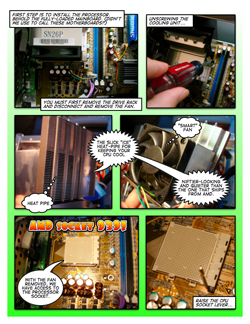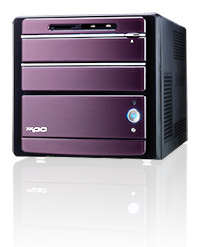
If I can do it, you can do it. Over on the just-launched Create Digital Motion, I describe assembling a custom PC from a barebones Shuttle case, with photos of each step. To keep that from getting boring, I dropped it all into the fantastic plasq app Comic Life to make it into a how-to comic:
Building a Portable SFF PC for Live Visuals, Music Gigs: Part 1, Assembly in Comic Book Form
As you’ll see, there’s not much to it. Shuttle already includes the motherboard and cables; it’s BYO processor, storage, and graphics. But those options alone can give you a lot of flexibility you don’t get from pre-built systems.
We’ve talked a lot about options for gigging with computers on this site. Laptops remain the most portable alternative by far, of course, and they’ve gotten very powerful. As I noted for Macworld, the MacBook Pro can keep pace with even my dual-2.5GHz G5. So why have I suddenly shifted gears and built a desktop form factor PC? One major reason is the ability to have an upgradeable video card for gigs, which is why the story is on CDMotion rather than here. Sure, Apple will ship a competent ATI Radeon Mobility X1600, but you have to splurge on the Pro rather than the MacBook, there’s only one card with one output, and it’s not upgradeable.
Video aside, there are plenty of reasons mainstream audio users might consider a desktop form factor machine for music production:
- Price and upgradeability: Desktop machines still cost less at time of purchase, and (on the PC) even less over time thanks to upgradeable components.
- PCI expansion: Just as I wanted PCI slots for my video work, you might want to be able to move PCI-based audio cards and DSP cards out of your studio. There are some options, like the TC Electronic PowerCore’s mobile FireWire DSP hardware, which totes nicely with your laptop. But if you’ve invested in PCI cards, you might like a lightweight desktop that goes where you go.
- Storage: 7200 rpm drives are a must for multitrack recording, and RAID arrays give you the option to either have redundant storage (RAID 1 or “mirrored”, so that if one drive fails, the other retains your data), or faster performance (RAID 0 aka “striped”). It’s possible to custom-configure laptops with 7200 rpm drives or even fast 5400 rpm drives, and you can now buy external RAID arrays or cheap backup drives. But PCs make these options much cheaper. (Note that my Shuttle PC features a more-common “software” RAID, which uses a combination of a hardware controller and special software drivers to run the RAID; it’s not quite as reliable or fast as a true dedicated hardware RAID, but it also saves a lot of money and doesn’t require an extra PCI-x slot. And it works, with some caveats I’ll talk about later …)

I still expect laptops will be the best option for most users, but small desktops remain an option worth considering, especially if you’re not allergic to Linux and Windows or if you already have a decent laptop and want a second machine.
Now, what about small form factor (SFF) PCs versus rack-rig PCs and Macs, as covered previously? For me, it ultimately came down to a question of just how portable this rig was going to be. I need to be able to get on planes and trains with my setup, and a full rack is just way too much for a shrimpy guy with no car to lug. There’s also not much need for me to put stuff in a rack. Most of what I use runs in software, and keyboards are too long to fit. The Shuttles are really, really small — more on that, and how this setup fits in Shuttle’s custom carry-on luggage, coming soon.
In the meantime, enjoy the assembly comic, and if you’ve never considered building a custom PC before, do let me know your impressions.